HW Community
Meet the Himachali leading BSF’s extraordinary Mt. Everest expedition
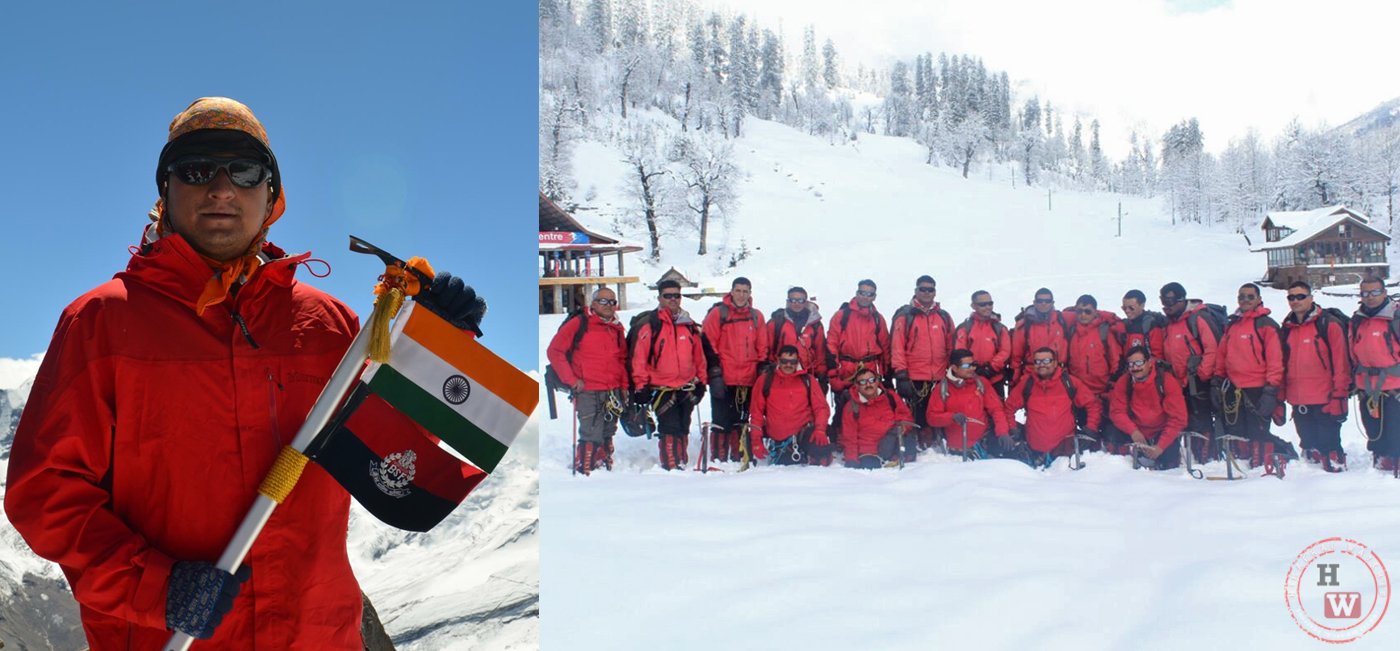
He is a certified mountaineer, paraglider, skier and has passed advanced courses in these adventure sports with excellent grades.
Shimla: What does it mean to lead a team of 25 members on an extraordinary expedition to scale the Mount Everest, the highest mountain in the world, and bring them all back safely alongwith collecting and bringing back 1000 kilograms of non-biodegradable waste left by other mountaineers?
Considering the challenges that the mighty Everest throws up, it would be a hell of a job for any leader, we believe.
The expedition is real and Col. Rajyavardhan Singh Rathore, Union Minister of States for the Youth Affairs and Sports has already flagged off this 90-day expedition of the Border Security Forces (BSF) on March 20, 2018.

BSF Team
As a matter of proud for Himachal Pradesh, Kinnaur’s Avinash Negi (37), who is currently serving as the Deputy Commandant, BSF, has been elected as one of the two leaders for the expedition alongside Padma Shri Love Raj Singh Dharamshaktu, Assistant Commandant, who has scaled Everest six times.
Himachal Watcher talked to Avinash to know more about this extraordinary expedition and about him. We found out that the officer is not only an adventure sports lover but also has his own philosophy that has been shaped by the mountains or adventures he experienced.
Before, talking about Avinash, first, we should get an outline of the expedition and its objectives.
The prime objective of the Expedition is to pay reverences to the goddess of mountains and to hoist Tricolour on the top of world’s highest peak under the campaign ‘Clean Himalayas, Clean Glaciers’. This gesture will not only sensitize the locals and mountaineers and trekkers community towards cleanliness but also help us spread the message of Swacch Bharat Mission to neighbouring countries.
37-Day Training for the Expedition
Avinash and other team members have undergone a rigorous training of 37 days in the Pir Panjal and Dhauladhar ranges in Manali to prepare for the expedition.
Basically, all the team members are qualified mountaineers, therefore, the focus of the training was to increase endurance and stamina,
Avinash told HW.

Their days began with running in hills for nearly 15 to 20 kilometres with their back-packs on, followed by handball or football games and yoga classes under a trained yoga instructor.
In yoga sessions, they mostly concentrated on the breathing practices. Besides this, they also did snow and ICE climbing – the most essential part of the Mt. Everest Expedition.
Other than that, the team members scaled peaks upto altitudes of 14,000 to 15,000 feet. The focus was on trekking with full gears with night climbing exercises as all the journey performed and route travelled above the base camp of the Everest is usually undertaken at early mornings or late nights, Avinash said.

Avinash during the training period
The reason behind night climbing is that during the daytime, the probability of avalanches is higher due to the melting effect of sunlight deep within glaciers.
The training also included lectures on the first aids, CPR practice, and ladder crossing which is used to cross craves.
He further informed that normally, upto the base camp, one person carries a weight depending on his needs. Nevertheless, the weight of the essential equipments like oxygen cylinders, food and water reach upto 15 to 18 kilograms.
The most important question was that how the team would bring down the collected 1000 kilogram of garbage, as it is a gigantic amount for 25 men.
We will be collecting and carrying the garbage in parts. We will go to the camp one and two for acclimatisation. During this period, the team will be returning to the base at least thrice,
he explained.
During these visits, we will collect the non-biodegradable garbage from these camps. This garbage will be transported back during the returning journey after the summit, he further added.
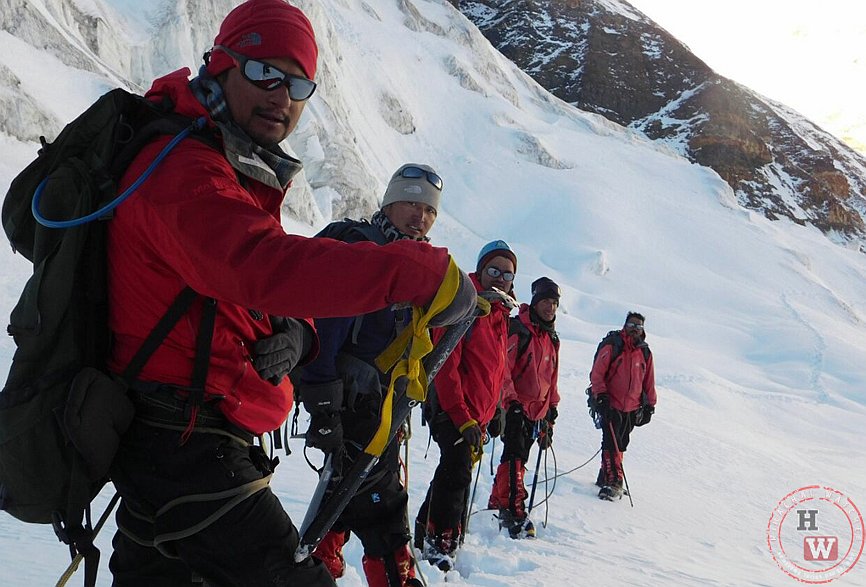
BSF team members during the training period
Thereafter, with the help of supporting staff and service providers, the team will carry it to the base camp. The garbage will be transported to Nepal through yaks for a proper disposal.
When asked as to what does it mean for him to lead a team and scale the highest mountain in the world, he replied,
The best view comes after the hardest climb and taking no risk is the biggest risk of life.
I am fortunate enough to be the second leader alongside Padma Shri Love Raj Singh Dharamshaktu. He has a vast experience in mountaineering, and it is my sheer pleasure that I am chosen for the responsibility,
he added.
It is a big responsibility because above 8000 meters, there starts the death zone – the term usually used by climbers.
When asked whether he was feeling any nervousness, he replied,
We are ready to take on the challenge as we have rigorously practised for the mission. But, I once again reiterate that we are nothing in front of the mountains and nature. It is our endeavour and we will succeed in it, I believe. I take challenges as they come. We are here and we are geared up.
About Avinash Negi

Born in the mountains of Kinnaur district, he has a rich history of adventure sports. His father, Mr K.C. Negi, is a retired IIS officer, who has served with the Govt of India.
Avinash received his higher education from the Punjab University.
He cleared the Union Public Service Commission CPF-2007 Examination in 2008 and joined the Forces. He underwent 14 months of training at the BSF Academy.
Currently, he is about to complete nine years of serving in the BSF
When asked whether he always wanted to join forces, Avinash replied,
Yes, I always had a liking for the armed forces and uniform. I am happy to be part of it.
Besides undergoing routine courses of the BSF, he has tried his luck in the field of adventure sports too.
I started my adventure career with my basic and advance mountaineering courses, which I took at the Atal Bihari Vajpayee Institute of Mountaineering and Allied Sports (ABVIMAS), Manali.
During the basic and advance courses, I was exposed to heights. I climbed to the height of 15500 feet in basic training and upto 17,900 feet in Pir Panjal Ranges of Manali,
he added.
Besides climbing some routine unnamed peaks, he has successfully attempted the following peaks:
- Mt Friendship Manali, HP, (17,900 feet)
- Mt Rudurgera, UK ( 20,000 feet).
- Mt Gangotri Group of peaks, UK (21,700 feet)
- Jogin 1 and 3 Expedition UK (215k -20100 feet) as the Deputy Leader alongside Lovraj Singh Dhramsaktu- his mentor
That is not all about him. He is also a passionate paraglider and has taken several courses at Bir Billing in Kangra. He is a certified pilot for solo paragliding, for which he has completed all three levels – P1, P2, and P3 courses at Gurukul paragliding school in Bir Billing.
There, Mr. Gurpreet Dhinsa, the Ace paragliding pilot of India, remained his mentor.
He did not stop here and underwent advance courses like thermalling and cross-country paragliding courses that added to his flying hours and let him fly next to clouds.
He is also a qualified skier. He has taken the basic and intermediate courses at the ITBP, Auli and advanced courses at the Garhwal Mandal Vikas Nigam, Uttrakhand, with excellent grades.
You must go on to adventures to find out where you truly belong,
he replied when asked if he would call himself a passionate mountaineer.
I am born and brought up in mountains like any other Himachali, especially the upper regions. The mountain always fascinates me and brings out the best in me,
he said.
The best place to find your self is mountains. They teach you discipline and lessons that you never learn in classrooms. The first one is that the friends we make in mountains are for the lifetime because the people who stand by your side selflessly in the times of adversity are the ones whom you can bank upon blindly, Avinash said.
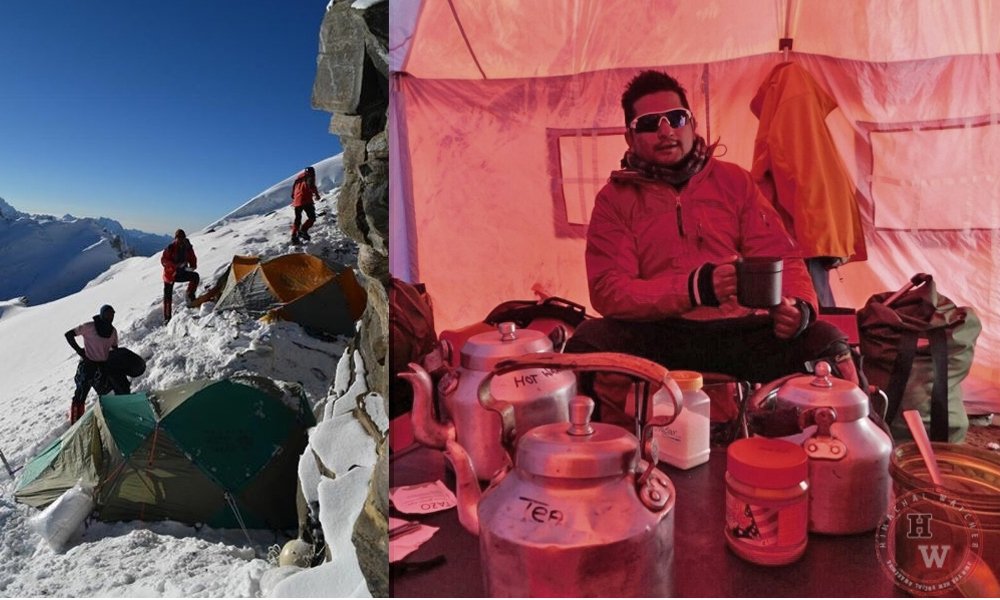
Avinash during the training period
He holds an opinion that the adventures open up one’s perspective towards life. People who are into mountaineering and adventure sports see life differently.
They are more docile, trustworthy, disciplined, punctual, lively, and helpful because mountains teach and inculcate these qualities in them, he said.
Nature is supreme and we humans are just a nought in front of it. Therefore, any mountain we scale should be done by seeking the permission of the mountain itself, he believes.
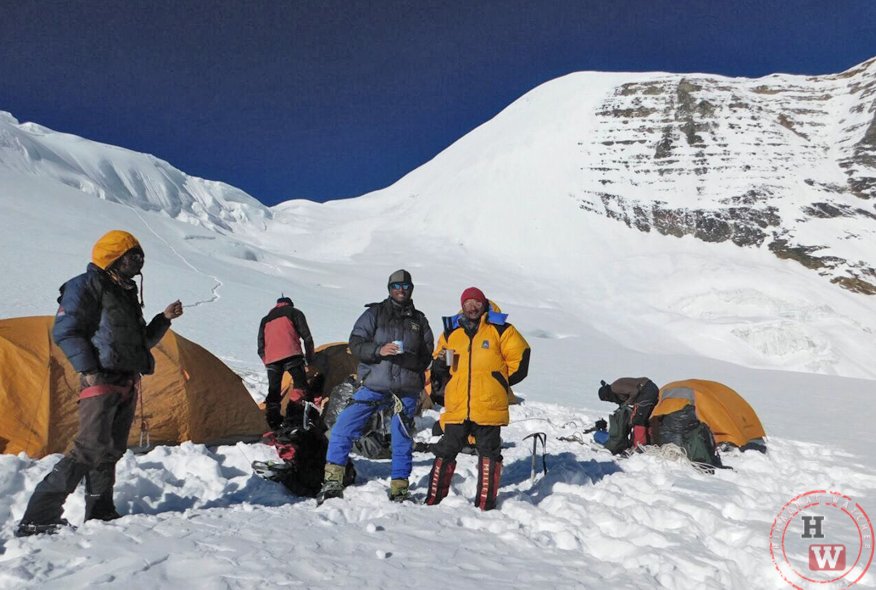
He always liked the saying “mountains are calling and I must go”. The life depends on nature; therefore, only being disciplined and obedient will help us carry forward our mission successfully.
The mountains also teach us the reality of life. The days we spent on mountains are with limited things, be it edibles or limited space to sleep.
The two men tent and some warm water offered by someone becomes luxury when you are down. A small space of just 24 square feet inside the tent looks far bigger than any king size bed. There we learn the value of things like food and water, which help us understand how little the requirements of a human being are.
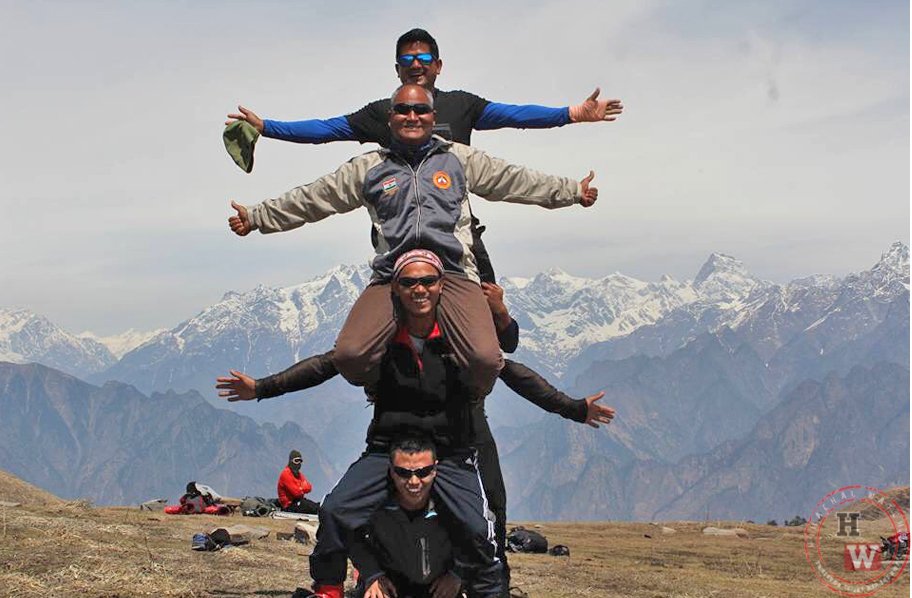
Leisure moments during paragliding session
He believes there is a child in all of us and we should let that child live within us, otherwise, we are nothing more than machines.
Adventure helps add on to one’s decision-making ability, which is why all the corporates are also making it compulsory for their employees to undertake adventure activities once in a year. Most of the schools have also included adventure activities in their routine curriculum, he said.
I recommend all go outdoors. Being outdoor does not necessarily mean climbing a mountain or flying in thermal. Even a little exposure may help us realise what we actually are and what we actually want in life,
he said.
When he is off duty or on leave, then there is nothing better than a sunny evening, light music, and a broad view ahead. He loves long drives and makes it a point to carry his iPods with him.
He is not unaware of the dangers and risks involved in adventure activities. His advice is that adventure and accidents are closely associated. So it should only be undertaken under the supervision of a trained person until one becomes capable enough to do it on his own. All these activities look sounds adventures and charming but they involve a lot of risks too. Therefore, surveillance on a learner’s activities by an expert is a must.
HW Community
PIL Filed in HP High Court Re-Ignites Quest for Recognizing Pahari (Himachali) as Hill State’s Official Language

Shimla- November 10, 2021, Himachal Pradesh High Court on Monday passed an order concerning a public interest litigation (PIL) seeking to recognize Pahari (Himachali) as an official language of the state. The petition also sought effective steps on the part of the government to preserve and promote the Pahari language in the State as its culture and language give it a distinct identity.
The Public Interest Litigation was filed by Arsh Dhanotia with a prayer that the state be directed to declare Pahari (Himachali) as one of the official languages in the State of Himachal Pradesh in any script and also promote further research towards a long-term formal Pahari (Himachali) nuclear language structure and nuclear Tankri script.
Bhawani Pratap Singh Kutlahria, the advocate for the petitioner, argued in the court that the State Government be directed to promote Pahari (Himachali) and other local languages as the medium of instruction in primary and middle-level schools as per the New Education Policy, 2020. On behalf of the petitioner, he also prayed the court to direct the state government to include Pahari (Himachali) language as a separate category for the 2021 Census and simultaneously undertake an awareness campaign to create awareness amongst the masses, especially the youth of the State who speak Pahari (Himachali), to get it marked as their mother tongue in the upcoming Census.
A bench of Chief Justice Mohammad Rafiq and Justice Sabina while disposing off the PIL stated,
“The direction as has been prayed for, cannot be issued to the State Government until and unless it is established on record that the Pahari (Himachali) language has its own script and that a common Pahari dialect is spoken throughout the State of Himachal Pradesh. We, however, set the petitioner at liberty to approach the Department of Language Art & Culture to the Government of Himachal Pradesh with his demand for undertaking research to promote a common Pahari (Himachali) nuclear language structure and nuclear Tankri script. If the petitioner approaches the respondents-State through its Additional Chief Secretary (Language Art & Culture) to the Government of Himachal Pradesh) for the prayer made in the Civil Writ Public Interest Litigation, it would be for the said authority to consider the same in accordance with the law.”
Additionally, the petition had emphasised that Sanskrit, which is the second official language of the state, had only 936 speakers according to the 2011 census and Pahari (Himachali) dialect chain which is spoken by more than 40 lakh people was being neglected and has not been made an official language even after having so many speakers.
The petition also highlighted works of Former Chief Minister Late YS Parmar and Former Education Minister Late Narain Chand Parashar towards the promotion of the Pahari (Himachali) language.
What’s Pahari (Himachali) Language, How Many Districts It Covers
It is to be noted that according to the petitioner, Pahari (Himachali) is a combined term used for the Western Pahari dialect chain spoken in Himachal Pradesh and majorly includes Kangri, Mandeali, Chambeali, Kulvi, Mahasu Pahari and Sirmauri. According to him ever since the creation of Himachal Pradesh, there has been a demand for recognition of Pahari (Himachali) under the Eighth Schedule of the Indian Constitution and it is also officially listed with 37 more languages as a language which is in significant demand to be included in the scheduled languages category.
In his plea, he also stated that the Himachal Pradesh Vidhan Sabha in 1970 and 2010 have also passed resolutions concerning the promotion and development of Pahari (Himachali).
Environment
Himachal’s Snow Covered Area Has Decreased, Poses Big Threat to State Economy’s Lifelines: Report

Shimla-The area under snow cover in Himachal Pradesh has declined by 18.5% according to a recent report published by State Centre on Climate Change (SCCC) and Space Application Center (ISRO) Ahmedabad. The report revealed this decreasing trend for the five major river basins in the State.
As the report points out, the high altitude regions of Himachal Pradesh receive precipitation mainly in the form of snow during the winter season. One-third of the geographical area of the state is covered by a thick blanket of snow during the winter season. Rivers like Chenab, Beas, Parvati, Baspa, Spiti, Ravi, Sutlej and its tributaries flowing through Himachal are dependent on snowfall in winter. These rivers mainly feed into the Indus water system and a decline at this rate rings a death knell for water and also food security for millions of people from Himachal to Kashmir, the plains of Punjab, the food bowl of the country.
Using images and data received from satellites, the report states, that the winter precipitation was mapped in all the basins from October 2020 to May 2021 (a period of two years). The findings indicate that there has been an average decrease of 8.92 percent in Chenab basin, 18.54 percent in Beas basin, 23.16 percent in Ravi basin, 23.49 percent in Sutlej basin compared to last year. The ice covered area of Chenab basin was 7154.11 sq km in 2019-20, which has come down to 6515.91 sq km in 2020-21. Similarly, Beas basin was reduced from 2457.68 to 2002.03 square kilometer, Ravi basin from 2108.13 square kilometer to 1619.82 square kilometer and Sutlej from 11823.1 square kilometer to 9045 square kilometers. Overall, the snow covered area was reduced from 23542 square kilometer to 19183 square kilometer in the entire Himachal.
Sutlej Basin covers 45 per cent of the total geographical area of Himachal and it is the longest river of the state. It flows for around 320 kms here, passing through Lahaul and Spiti, Kinnaur, Shimla, Kullu, Mandi, Solan and Bilaspur districts, along its course. The above study shows that the maximum reduction in snow cover has occurred in the Sutlej basin. An area of 4359 square kilometers under snow cover has decreased for the whole state, of which more than half of the Sutlej Basin.
Just two years ago another study had indicated that more than half of glaciers in Sutlej Basin are set to vanish by 2050. Yet another study also showed that the Sutlej basin has the highest 562 number of glacial lakes. These lakes stand the risk of sudden outbursts, which then causes flash floods downstream as the valley has already experienced. So, while the crisis that is unfolding, be it deglaciation, lake formation or reduction in area under snow cover, it seems that the Sutlej river basin is more vulnerable to these changes.
Prakash Bhandari, an environmental researcher and activist and member of Himdhara Collective expressing his concern states that the situation in the Sutlej river basin is certainly indicative of a serious climate emergency and it is critical to look into the drivers of this both local and global.
“The Sutlej basin catchment is the largest and so the changes visible here are more significant. Many factors have worked together to create this crisis which should be studied closely. There is no doubt that global warming is contributing to these changes. But the local conditions also play a role in reducing or increasing its impact”, he says.
The upper reaches of the Sutlej Valley, especially areas like Kinnaur are geologically fragile, with sharp gradients and loose soil strata. Vegetation is in a very small area so the proneness to erosion. We have seen the catastrophic impacts of flashfloods and landslides over the last decade and a half, where crores worth of property has been damaged. This year saw a spate of landslides where lives were lost. “In such a sensitive and also strategically important area, changes in the landscape will have far reaching and irreversible impacts. More construction activities will lead to more deforestation, more erosion”.
Construction of dams has been rampant in the Sutlej valley, a phenomena that started post independence and continues today. If all of the planned dams are built the Sutlej will be cho-a-cloc with more then 150, large and small projects. At the bottom of the valley in Bilaspur is the Bhakra Dam, built almost 6 decades ago, which has a size of 168 sq km and a storage capacity of 9.340 cubic km. Is. This is followed by the Kol Dam which extends for 42 km up to Sunni, which has a total storage capacity of 90 million cubic metres. Nathpa Jhakri Project which is 27.394 kms. is long. When a dam is built, a huge amount of water is stored. The debris of many villages, trees etc. also gets absorbed inside the dam. When water is stagnant, it receives heat from the Sun to form mist in the surrounding area by evaporation and simultaneously generates methane gas. The experience of the lake formed by the Kol dam at Tattapani in Mandi district shows that the area is experiencing heavy haze which was not there earlier.
“In the 30s and 40s, Shikari Devi and Kamrunag used to have snow on the peaks for about 6 months, which now could barely stop for only 2 months. The air route distance of Shikari Devi and Kamrunag is only 26 to 30 kms from Tattapani lake. At the same time, their distance is not much from the cement factories of Darlaghat, Sundernagar”, the elders in the area say. “Today, fog is prevalent and this has also made the area warmer”.
Due to the warming of the weather due to the clouds formed from the mist, the snow has started melting quickly. Apart from this the local crop patterns are affected. Post the 1990s, the Sutlej became a site for run of the river hydroelectric projects using extensive underground tunneling. This involves massive use of explosives for blasting through the mountains. Of the 23,000 MW worth of projects to be constructed in Himachal more than 10,000, a third are from this valley alone. Kinnaur continues to be a hydel powerhouse with 10 run of the river projects in progress and 30 more to be set up including two mega projects of 1500 MW and 1000 MW each. This paints a scary picture.
Interactive Sutlej River-Basin Map indicate Hydropower Station location
It is not just the hydro-electric dams but unplanned tourism and other development activities like mining, cement plants, road expansion and mindless construction across the high Himalayan regions have also add to the shift in local weather patterns, land use changes and thus the ecological crisis. But the reason why we should put the limelight on hydropower is that this is being pushed as “Green Energy”, in the name of climate change mitigation. As opposed to other forms of generating power, hydropower projects are said to cause lesser carbon emissions, which is why there has been a global push to shift to renewable resources. But the climate emergency in the Himalayas has put a question mark on ‘water’ as a renewable resource.
The question then arises that with all this data indicating a steady decline in river discharge and snow cover have our planners and policy makers not considered what will happen to these projects? Will they be able to generate the power they propose to? The people of Himalaya have to wake up to this wastage of public resources. Scarce funds should be diverted to better planning for securing local livelihoods by protecting the forest ecosystems and water sources for the future.
Author: Gagandeep Singh-From Himdhara (Environment Research and Action Collective)
Feature Images: unsplash/@raimondklavins
HW Community
Himachal: Warnings of Delta Plus Virulence Fall on Deaf Ears, No Restriction on Visitors from Affected States

Shimla-Yesterday, the Centre government directed the state governments to take immediate measure in wake of the spread of more infectious Delta Plus variant. As the Delta Plus variant is posing a threat of the third wave, the states were told to take steps like preventing crowds, increase testing, more focus on surveillance, contact tracing and put boosting vaccine coverage on a priority basis. Following it, Himachal Pradesh Government might have announced an alert over Delta plus variant, but there wasn’t any follow up on instructions passed by scientists and health experts to take strict restrictive measures ahead of the impending third wave.
To make it worse, high rank officials and political leaders were seen flouting Covid-19 SOPs on several occasion, which sent wrong messages to the masses. The pictures and videos showing flouting of Covid appropriate behavior by Chief Minister Jairam Thakur and Directorial General of Police, Sanjay Kundu, alongwith other staff for Anupam Kher is the most recent to mention. A group photograph and video of the same were widely circulated on social media and invited huge criticism from the people.
So far, the state has not reported any case of the Delta Plus variant. But the neighboring states – Punjab, Haryana, and Jammu & Kashmir – reported their first cases yesterday. This puts the boarding areas, like in Una district, at a higher risk. Chief Secretary to HP Government, Anil Khachi, yesterday said samples have been sent for genome sequencing.
Despite repeated warnings of Delta plus variant (B.1.617.2.1.), Himachal Pradesh has thrown its borders open to all and lifted all restrictions for inter-state travel in just one go. From June 23 onwards, the state government removed the condition for registering on the e-pass portal for visitors intending to enter the state. In the Cabinet meeting held on June 22, 201, the government first decided that e-pass restrictions would be removed from July 1, but later it changed the decision and instead implemented it immediately.
This haphazard decision is said to have come under huge pressure from the hospitality industry – the worst-hit sector, leading to financial crisis and mass unemployment among its stakeholders. Related associations had been approaching Chief Minister Jairam Thakur with their pleas to provide relief, but mostly faced disappointment. The stakeholders say the state government didn’t provide any significant relief, which is making the survival of the industry difficult.
Also Read: Read Eight Reliefs That Himachal’s Devastated Tourism Industry Seeks from HP Govt
Also, stakeholder of the industry, especially hoteliers, had been demanding the removal of restrictions and conditions on the entry of tourists to Himachal so that they could fetch the remaining peak tourist season.
With its inability to offer relief, the HP Government took the chance to waive off restrictions in a haste.
At the same time, the state government has decided to conduct offline examinations for the undergraduate classes starting from July. A section of the students had been condemning the HP government for scheduling exams without vaccinating students. Some student bodies had been asking the government as to why online classes were possible but not online exams.
The state government also waived off restrictions on timings for the opening of markets/shops.
As scientists and health experts warn of the virulence of the new variant and with neighboring states already on alert after reporting cases of the new variant, the HP government hasn’t even mentioned any intention to at least put a check on the visitor from the states where cases of Delta Plus are being reported. Carrying an RT-PCR negative report for visitors from such states/cities would have been a wiser step.
Officially, the state is on alert, but no measures have been announced to check the entry and spread of the variant into the state. The state government does speak of preparing for the anticipated third wave, but there is hardly any long-term preventive strategy. The Covid appropriate behavior is hard to adopt when markets and tourist places are crowded with visitors.
Why Delta Plus is a Big Concern
The World Health Organization (WHO) has labelled the Delta variant as ‘Variant of Concern’.
The Centre and scientific/medical institutes in India also agree with that Delta Plus as a variant of concern and could be the cause of impending third wave. Last Tuesday, based on the findings of INSACOG, the Union Health Ministry had alerted and advised Maharashtra, Kerala and Madhya Pradesh regarding the Delta Plus variant of COVID19.
INSACOG had warned that the Delta Plus variant has increased transmissibility, stronger binding to receptors of lung cells, potential reduction in monoclonal antibody response.
“Delta variant is more resistant to medication, treatment and vaccination. Therefore, people who have been vaccinated can still be affected by this variant and can go on to get a clinical illness, Archana Dhawan Bajaj, director, Nurture IVF, told a national English Daily.
“Neutralising antibodies against this variant post-vaccination seem to be nearly five times lower in people who have already been vaccinated than the other variants,” she said.
Further, Dr Raman Gangakhedkar, ex-Head Scientist of Epidemiology and communicable diseases, ICMR, has also expressed concern over the reports that Delta Plus has reported pathophysiologic change and affecting different organs. Dr Raman says that it could transfer from cell to cell and would more likely produce neurological symptoms as a common manifestation.
So far India has reported 51 cases of the Delta Plus variant.
Delta Plus variant is a variant of Delta with an additional mutation -B.1.617.2.1.




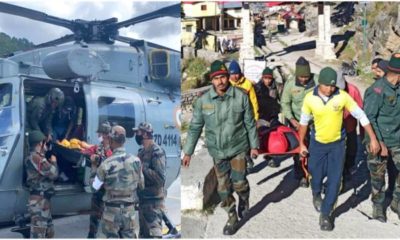

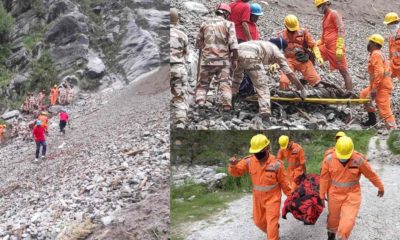








 Home Decor Ideas 2020
Home Decor Ideas 2020
